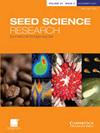Effects of light and temperature on seed germination of eight Cistus species
IF 1.9
3区 生物学
Q2 PLANT SCIENCES
引用次数: 2
Abstract
Cistus species have seeds with hard coats which impose physical seed dormancy that can be released after seed scarification. In fire-prone habitats, the break of physical seed dormancy is usually related to the heat produced during fires. It is commonly accepted that most hard-seeded species, including those of the genus Cistus, are able to germinate under a wide range of temperatures in light as well as in darkness, once the seed becomes permeable. However, although many studies have focused on the release of physical dormancy only, a few have done so on the effect of environmental factors once dormancy is released. In this research, through a factorial experiment, we analysed the effects of light (light and darkness) and a range of temperatures (10, 15, 20, 25 and 30°C) on the seed germination of eight Cistus species after a heat shock. On average, almost 60% of the seeds did not germinate despite being viable, and this lack of germination increased with higher temperatures during the treatment. Although an idiosyncratic germination response emerged, temperature had a significant effect in all the species, reaching the highest levels of germination between 10 and 20°C. Light interacted with temperature in four cases by increasing the germination, especially under the least favourable temperatures. Environmental factors, such as temperature and light, appear to modulate the germination of the studied Cistus species after the release of physical seed dormancy.光照和温度对八种肉苁蓉种子发芽的影响
Cistus物种的种子有坚硬的外壳,这会造成种子的物理休眠,种子松土后可以释放。在火灾多发的栖息地,种子物理休眠的打破通常与火灾期间产生的热量有关。人们普遍认为,大多数硬籽物种,包括Cistus属的物种,一旦种子变得可渗透,就能够在光照和黑暗中在大范围的温度下发芽。然而,尽管许多研究只关注物理休眠的解除,但很少有研究关注休眠解除后环境因素的影响。在这项研究中,通过因子实验,我们分析了光照(光照和黑暗)和温度范围(10、15、20、25和30°C)对八种Cistus在热休克后种子发芽的影响。平均而言,尽管有活力,但几乎60%的种子没有发芽,而且在处理过程中,随着温度的升高,发芽率的降低也会增加。尽管出现了特殊的发芽反应,但温度对所有物种都有显著影响,在10至20°C之间达到最高发芽水平。在四种情况下,光通过提高发芽率与温度相互作用,尤其是在最不有利的温度下。在物理种子休眠解除后,温度和光照等环境因素似乎会调节所研究的Cistus物种的发芽。
本文章由计算机程序翻译,如有差异,请以英文原文为准。
求助全文
约1分钟内获得全文
求助全文
来源期刊

Seed Science Research
生物-植物科学
CiteScore
3.60
自引率
4.80%
发文量
23
审稿时长
>12 weeks
期刊介绍:
Seed Science Research, the official journal of the International Society for Seed Science, is a leading international journal featuring high-quality original papers and review articles on the fundamental aspects of seed science, reviewed by internationally distinguished editors. The emphasis is on the physiology, biochemistry, molecular biology and ecology of seeds.
 求助内容:
求助内容: 应助结果提醒方式:
应助结果提醒方式:


